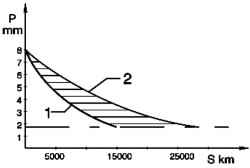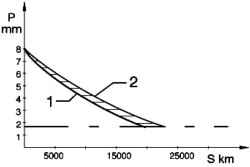 printable version printable version
Tyre service
The air pressure in the tire Vehicle weight flattens a tire on the area of its contact with the road. Tire rolling leads to a forced deformation of the tread and around the belt. With low pressure forced deformation increases, thereby increasing the temperature and rolling resistance. These factors lead to increased wear and a negative impact on traffic safety. Too high air pressure in the tire leads to increased wear on the middle portion of the tread and impairs comfort. It is recommended to always keep the tire pressures specified by the manufacturer.
NOTE The graphs do not apply to the whole range of products. They are required to show the wear of the tires on the front and rear axles, as well as the wear of the tires on cars with front-wheel and all-wheel drive. Depending on the operating conditions and chassis achievable tire life can greatly deviate from the below.
|
Tread depth throughout the life of vehicles with front wheel drive and the tires with speed symbol V.
P - The height of the tread pattern. S - Run. 1 - front axle. 2 - Rear axle.
Tread depth throughout the life of vehicles with all-wheel drive and the tires with speed symbol V. P - The height of the tread pattern. S - Run. 1 - front axle. 2 - Rear axle. As seen from the graphs 1 and 2, with a complete tire tread during certain mileage wear more significantly than a worn tire. After the first 5,000 km can not be judged on the overall life of the tire, since the characteristics of nonlinear deterioration passes. On front-wheel drive vehicles, except for efforts during cornering and acceleration, forced to withstand most of the lateral and braking forces. Because of these loads the tires on the front wheels of front-wheel cars wear out much faster than the rear wheels. Even wear of the tire is achieved by regular rearrangement of the front and rear wheels.
| 





